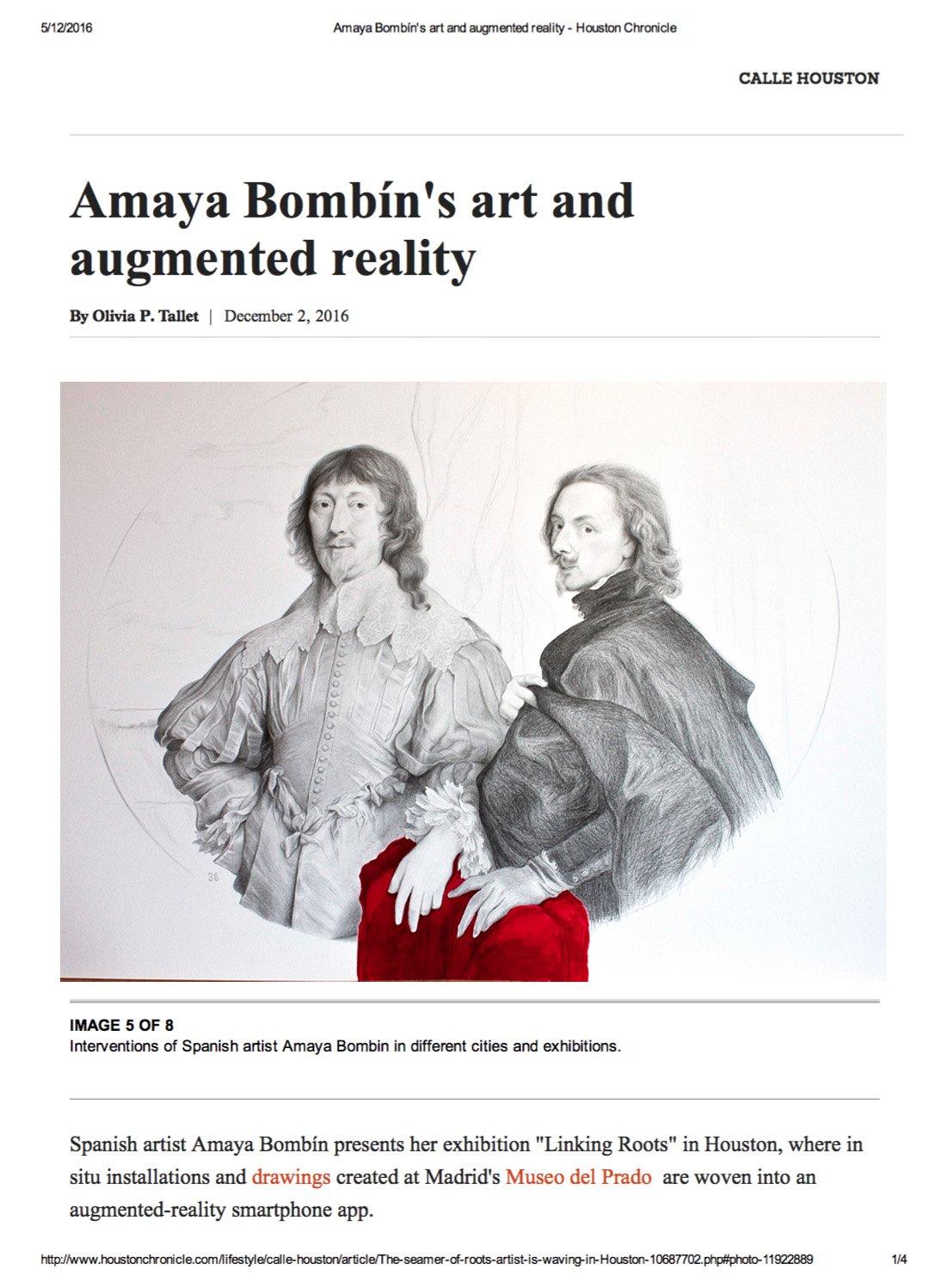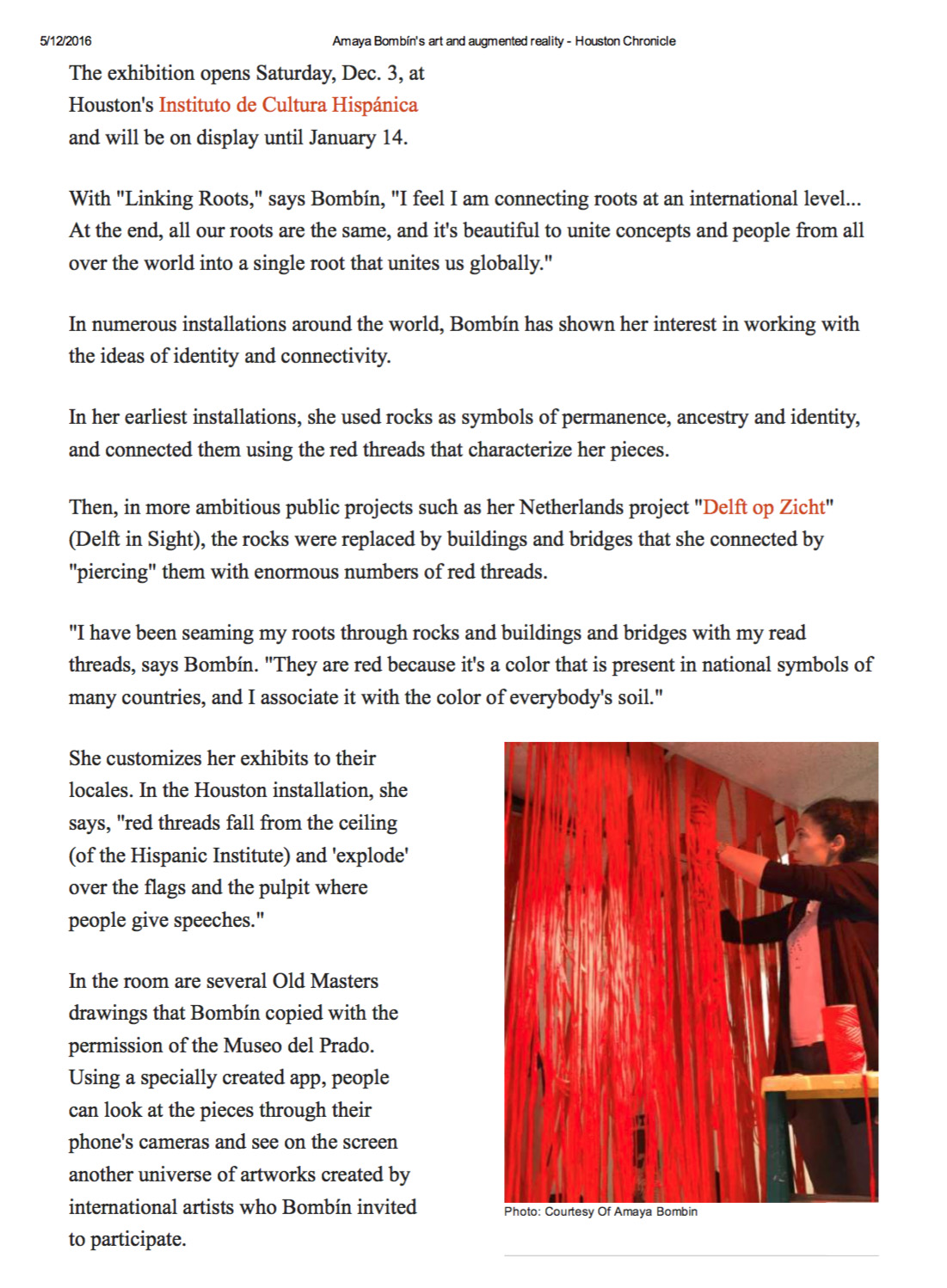Linking roots
Project based on drawings with Augmented Reality and site-specific installations.
It has been exhibited in Houston (USA) and Genoa (Italy) in Contemporary Art Museum of Villa Croce.
It was selected by Spain's Ministry of Foreign Affairs and Cooperation (MAEC) and the Spanish Agency for International Development Cooperation (AECID) to develop in 2016 with the ART-EX grant.
Special thanks to: Consulate General of Spain in Houston, Institute of Hispanic Culture of Houston, Spain Arts&Culture and Pau Waelder for his wonderful text for the project (you can read it below or in the online catalogue).
Online catalogue: https://issuu.com/amayabombin/docs/amayabombin_catalogue_lroots
You can download for free the app "LinkingRoots" for enjoying the Augmented Reality in the drawings.
A Rolling Stone Gathers No Moss.
Pau Waelder.
Credited to Syrian writer Publilius Syrus (85-43 BC), this old proverb was meant to criticize nomadism and the attitude of those who refuse to root their activity in a particular place, become part of a established community, and settle down. In this interpretation, a rolling stone is a misplaced object that still has not found its proper place. It is also the opposite of what is expected of a stone as something static and immovable, as the foundation of a building, a city or a country. The proverb can also be understood in terms of our wandering mind: constantly drifting, carried by innumerable thoughts and stimuli, the mind never settles and finds it hard to concentrate, to stop the flow of thoughts in order to let the moss of new ideas slowly emerge.
In our restless, hyper-connected society, the proverb has adopted a different meaning, as it is understood that to be constantly on the move is a positive thing, the unceasing activity preventing the individual from gathering the moss of a dull, inactive, and unproductive life. It is also characteristic of a time when our attention span has been shortened due to the daily exposure to information overload. Data gathers like a dense moss around us, growing rapidly, so we need to shake it off, losing some of the information it contains. As a result, our observation of the things around us tends to be more superficial, while at the same time, we have the tools that allow us to access a deeper knowledge of what we see, read and hear, like never before.
Throughout her career, Amaya Bombín has explored the concepts of nomadism, connectivity, place and belonging, all of them related to an intimate knowledge of the history of painting and the perception of artistic practice as handicraft. Most of her projects deal with finding the roots, be it the material and cultural foundations of a particular site (usually represented by a heap of stones), or the connection between her own work and that of the Old Masters, not as a form of self-assertion, but rather as an honest inquiry into the weight that tradition places on every artist's practice. Connections are drawn in the form of long, red threads that traverse rooms, objects and drawings. They become tangible pencil strokes that leap from the artwork into the surrounding space, blurring the separation between the two. Stones and threads, as well as the color red (a color that instinctively inspires alert and equally symbolizes life and death) are therefore, the key elements in her work. Both appear as object and image, equally integrated in drawings and installations. However, while the red threads tend to be present in large groups, the stones are usually represented as individuals, sometimes isolated as in the prints of the project Roots (2013), as carefully drawn as the portraits by Van Dyck or Velázquez that the artist has copied at the Museo del Prado. Each of these stones is in fact a tsadi, the Hebrew word for pebble, which is also used to refer to the soul. The Jewish tradition of leaving a small stone on a grave also reminds us of the symbolic meaning behind Bombín's heaps of stones and her view of the pebble as representing an individual.
In Linking Roots, Amaya Bombín develops her research on these concepts a step further, by looking for roots and connections on a global scale and introducing Augmented Reality as a tool to expand the contents of her artworks. A series of twelve drawings display stones shaped after the outline of the territory of different nations. Each drawing is encoded in a way that can be recognized by Roots, a custom-made app for smartphones and tablets that enables the viewer to access a specific content triggered by each image. In this manner, viewers can look at the drawing and afterwards reveal through the screen of their mobile device the work of another artist who has been invited to participate in this project. Bombín therefore suggests using these devices as tools of observation instead of distraction, and draws connections between her work and that of other international artists. A second series of drawings shows red shapes, similar to stones and covered with a pattern of crossing lines, that also reveal additional contents when seen through the AR app. In this case, Bombín's drawings at the Museo del Prado and a videos of a woman weaving fabric in Vietnam connect the artworks to high art and handicraft, both being the roots of the artist's practice.
A "rolling stone" herself, Bombín is an artist who has carried out her work in many residences and travels around the world, developing a particular sensibility towards the specificity of each site and the need to visualize the threads that connect individuals. Despite the ephemeral quality of most of her work, it does gather moss: the invisible but long-lasting memory of an intervention, a trace, a call of attention to what, in an accelerated and restless society, is usually overlooked.

The project in the news.
_ In the Houston Chronicle:



_ In the Norte de Castilla newspaper:







